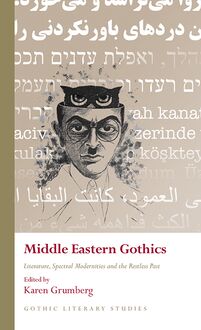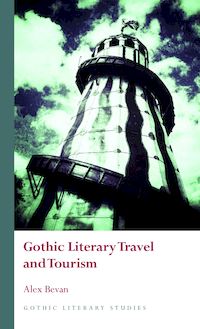Women's Authorship and the Early Gothic , livre ebook
141
pages
English
Ebooks
2020
Vous pourrez modifier la taille du texte de cet ouvrage
Obtenez un accès à la bibliothèque pour le consulter en ligne En savoir plus
Découvre YouScribe et accède à tout notre catalogue !
Découvre YouScribe et accède à tout notre catalogue !
141
pages
English
Ebooks
2020
Vous pourrez modifier la taille du texte de cet ouvrage
Obtenez un accès à la bibliothèque pour le consulter en ligne En savoir plus
Publié par
Date de parution
01 août 2020
EAN13
9781786836120
Langue
English
This edited collection examines Gothic works written by women authors in the late eighteenth and early nineteenth centuries, with a specific focus on the novels and chapbooks produced by less widely commercially and critically popular writers. Bringing these authors to the forefront of contemporary critical examinations of the Gothic, chapters in this collection examine how these works impacted the development of ‘women’s writing’ and Gothic writing during this time. Offering readers an original look at the literary landscape of the period and the roles of the creative women who defined it, the collection argues that such works reflected a female-centred literary subculture defined by creative exchange and innovation, one that still shapes perceptions of the Gothic mode today. This collection, then, presents an alternative understanding of the legacy of women Gothic authors, anchoring this understanding in complex historical and social contexts and providing a new world of Gothic literature for readers to explore.
Acknowledgements
List of Illustrations
List of Contributors
Introduction
Alternative Genealogies: (Re)tracing the Origins of Women’s Gothic in Sophia Lee’s The Recess and Mrs. Carver’s The Horrors of Oakendale Abbey - Anna Shajirat
Gothic before Gothic: Minerva Press Reviews, Gender and the Evolution of Genre - Hannah Doherty Hudson
What ‘Poor Mrs. Kelly’ Saw: Isabella Kelly Reads The Monk - Yael Shapira
Mary Robinson’s Gothic and the Prison of Gender - Deborah Russell
Adopting the ‘Orphan’: Literary Exchange and Appropriation in Eleanor Sleath’s The Orphan of the Rhine - Kathleen Hudson
The Fiction of Mary Julia Young: Female Trade Gothic and Romantic Genre-Mixing - Nicky Lloyd
Sarah Wilkinson and J. F. Hughes: A Literary Relationship - Franz Potter
Negotiating Gothic Nationalisms in Ann Radcliffe’s Post-1797 Texts: Gaston de Blondeville and St. Alban’s Abbey - Elizabeth Bobbit
Regina Maria Roche’s The Children of the Abbey: Its Literary Life and Afterlife - Christina Morin
Self-haunted Heroines: Remapping the generic “I” back into Romantic subjectivities - Elizabeth Neiman
Bibliography
Publié par
Date de parution
01 août 2020
EAN13
9781786836120
Langue
English
WOMEN’S AUTHORSHIP AND THE EARLY GOTHIC
SERIES PREFACE
Gothic Literary Studies is dedicated to publishing groundbreaking scholarship on Gothic in literature and film. The Gothic, which has been subjected to a variety of critical and theoretical approaches, is a form which plays an important role in our understanding of literary, intellectual and cultural histories. The series seeks to promote challenging and innovative approaches to Gothic which question any aspect of the Gothic tradition or perceived critical orthodoxy. Volumes in the series explore how issues such as gender, religion, nation and sexuality have shaped our view of the Gothic tradition. Both academically rigorous and informed by the latest developments in critical theory, the series provides an important focus for scholarly developments in Gothic studies, literary studies, cultural studies and critical theory. The series will be of interest to students of all levels and to scholars and teachers of the Gothic and literary and cultural histories.
SERIES EDITORS
Andrew Smith, University of Sheffield
Benjamin F. Fisher, University of Mississippi
EDITORIAL BOARD
Kent Ljungquist, Worcester Polytechnic Institute Massachusetts
Richard Fusco, St Joseph’s University, Philadelphia
David Punter, University of Bristol
Chris Baldick, University of London
Angela Wright, University of Sheffield
Jerrold E. Hogle, University of Arizona
For all titles in the Gothic Literary Studies series visit www.uwp.co.uk
Women’s Authorship and the Early Gothic
Legacies and Innovations
edited by
Kathleen Hudson
© The Contributors, 2020
All rights reserved. No part of this book may be reproduced in any material form (including photocopying or storing it in any medium by electronic means and whether or not transiently or incidentally to some other use of this publication) without the written permission of the copyright owner. Applications for the copyright owner’s written permission to reproduce any part of this publication should be addressed to the University of Wales Press, University Registry, King Edward VII Avenue, Cathays Park, Cardiff, CF10 3NS.
www.uwp.co.uk
British Library Cataloguing-in-Publication Data A catalogue record for this book is available from the British Library.
ISBN 978-1-78683-610-6
e-ISBN 978-1-78683-612-0
The right of the Contributors to be identified as authors of this work has been asserted by them in accordance with sections 77 and 79 of the Copyright, Designs and Patents Act 1988.
The publisher has no responsibility for the persistence or accuracy of URLs for any external or third-party internet websites referred to in this book, and does not guarantee that any content on such websites is, or will remain, accurate or appropriate.
Cover image: © Mary Evans Picture Library
C ONTENTS
Acknowledgements
Illustration
Notes on Contributors
Introduction
Kathleen Hudson
1 The Alternative Genealogies: (Re)tracing the Origins of Women’s Gothic in Sophia Lee’s The Recess and Mrs Carver’s The Horrors of Oakendale Abbey
Anna Shajirat
2 Gothic before Gothic: Minerva Press Reviews, Gender and the Evolution of Genre
Hannah Doherty Hudson
3 What ‘Poor Mrs Kelly’ Saw: Isabella Kelly Reads The Monk
Yael Shapira
4 Mary Robinson’s Gothic and the Prison of Gender
Deborah Russell
5 Adopting the ‘Orphan’: Literary Exchange and Appropriation in Eleanor Sleath’s The Orphan of the Rhine
Kathleen Hudson
6 The Fiction of Mary Julia Young: Female Trade Gothic and Romantic Genre-Mixing
Nicola Lloyd
7 Sarah Wilkinson and J. F. Hughes: A Literary Relationship
Franz Potter
8 Negotiating Gothic Nationalisms in Ann Radcliffe’s Post-1797 Texts: Gaston de Blondeville (1826) and St. Alban’s Abbey (1808)
Elizabeth Bobbitt
9 Regina Maria Roche’s The Children of the Abbey (1796): Its Literary Life and Afterlife
Christina Morin
10 Self-haunted Heroines: Remapping the Generic ‘I’ back into Romantic Subjectivities
Elizabeth Neiman
Bibliography
A CKNOWLEDGEMENTS
I would like to thank all the contributors to Women’s Authorship and the Early Gothic: Legacies and Innovations for their patience, hard work, outstanding research and personal dedication. Their passion for the subject matter is unparalleled, and without the enthusiasm and deep love of the Gothic they all share this project would never have become what it is now.
I would also like to thank Sarah Lewis, Andy Smith and all of the fine editors at the University of Wales Press for not only helping get this collection off the ground but also for their continued support throughout the publication process. Their feedback and editorial input have been immensely important for this work.
Special thanks to the academic institutions of all respective contributors for providing the necessary materials and support required to complete the research included in this collection.
Thank you to all of our family members, friends, peers and others whose love and support was instrumental in producing this work and bringing the collection together.
I LLUSTRATION
Figure 1:
M. R. Chateaudun’s musical composition ‘Adieu Sweet Girl’ (Philadelphia, PA, 1804?) https://www.loc.gov/item/2014568098/ p. 201.
N OTES ON C ONTRIBUTORS
Elizabeth Bobbitt earned her BA from the University of St Andrews and her Master’s Degree from the University of Salford at MediaCity. She recently completed her PhD at the University of York, where she researched Ann Radcliffe’s posthumously published works.
Hannah Doherty Hudson is an Assistant Professor of English at Suffolk University who has published extensively on eighteenth-century and Romantic popular print culture, the Gothic and the Minerva Press novel.
Kathleen Hudson is an Adjunct Instructor of English at the United States Naval Academy and Anne Arundel Community College. She is the author of Servants and the Gothic, 1764–1831: A half-told tale and numerous other works on gender, social class and the Gothic.
Nicola Lloyd is Senior Lecturer in English Literature at Bath Spa University. She is one of the authors of The Palgrave Guide to Gothic Publishing: The Business of Gothic Fiction, 1764–1835 and is currently preparing a scholarly edition of Mary Julia Young’s Donalda; or, the Witches of Glenshiel (1805).
Christina Morin is Lecturer of English at the University of Limerick. Her publications include foundational research in Irish and Gothic studies such as The Gothic Novel in Ireland, c.1760–1829 and Traveling Irishness in the Long Nineteenth Century .
Elizabeth Neiman is an Assistant Professor in both English and Women’s, Gender, and Sexuality Studies at the University of Maine. She is the author of Minerva’s Gothics: The Politics and Poetics of Romantic Exchange, 1780–1820 .
Franz Potter is an Associate Professor and Director of the MA in Gothic Studies programme at National University in Southern California. He is the author of The History of Gothic Publishing, 1800–1835 and has edited and republished numerous Gothic chap-books individually and in collections.
Deborah Russell is a Lecturer in the Department of English and Related Literature at the University of York and has published numerous articles and book chapters on Gothic fiction and women’s writing.
Anna Shajirat is an Assistant Professor of English at Quincy University. Her forthcoming research focuses on literature and culture of the long eighteenth century, particularly women’s Gothic writing on gender and race.
Yael Shapira is a Lecturer in the Department of English Literature and Linguistics at Bar-Ilan University in Israel. She is the author of Inventing the Gothic Corpse: The Thrill of Human Remains in the Eighteenth-Century Novel .
Introduction
KATHLEEN HUDSON
What I mean by Female Gothic is easily defined: the work that women writers have done in the literary mode that, since the eighteenth century, we have called the Gothic. But what I mean – or anyone else means – by ‘the Gothic’ is not so easily stated except that it has to do with fear.
Ellen Moers, Literary Women , 1976 1
‘Valancourt, and who was he?’ cry the young people. Valancourt, my dears, was the hero of one of the most famous romances which ever was published in this country. The beauty and elegance of Valancourt made your young grandmammas’ gentle hearts to beat with respectful sympathy. He and his glory have passed away. Ah, woe is me that the glory of novels should ever decay …
William Makepeace Thackeray, Roundabout Papers , 1860 2
‘… But are they all horrid, are you sure they are all horrid?’ Jane Austen, Northanger Abbey , 1817 3
There is an interlude in Regina Maria Roche’s 1798 Minerva Press novel Clermont during which the heroine, Madeline, finds temporary refuge from her ongoing adventures in a crumbling domestic structure, a space she shares with two female servants. As the women sit by the fire and listen to the storm raging outside, the looming threat of unspoken horrors becomes more and more apparent. Their solution to the resulting mental and emotional strain is as recognisable a strategy as it is a seemingly paradoxical one – in the following chapters Agatha and Floretta, the servants, perform three tales of terror for their own entertainment and that of their audience, Madeline. These stories are a patchwork of original invention, half-remembered gossip and a kind of unconscious genre literacy, employing recurring tropes of the Gothic, such as haunted buildings and spectral forces, while encouraging the audience’s emotional investment. The female narrators therein become metonymic Gothic authors, and the broader narrative purview is reflected in a mirrored version of itself.
Perhaps most notably, these stories are created, curated and critically evaluated by women who occupy a relatively vulnerable socio-economic position, and are presented to the middle-class heroine for her entertainment and edification. While no money changes hands in this scene there is an element of cre














